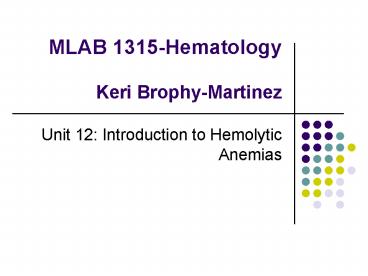MLAB 1315Hematology Keri BrophyMartinez - PowerPoint PPT Presentation
1 / 18
Title:
MLAB 1315Hematology Keri BrophyMartinez
Description:
Anemia caused by hemolysis of red blood cells, due to the trapping of cells in ... cells with these precipitates cannot deform to pass through microcirculation and ... – PowerPoint PPT presentation
Number of Views:75
Avg rating:3.0/5.0
Title: MLAB 1315Hematology Keri BrophyMartinez
1
MLAB 1315-HematologyKeri Brophy-Martinez
- Unit 12 Introduction to Hemolytic Anemias
2
Hemolytic anemia
- Anemia caused by hemolysis of red blood cells,
due to the trapping of cells in the sinuses or
spleen or liver. - Results in reduction of normal red cell
lifespan. - Normocytic, normochromic anemia
- RBCs are prematurely destroyed
3
Two categories of hemolytic anemia
- Intracorpuscular
- Intrinsic defect of the red cell
- Hereditary
- Defects of the red cell membrane
- Enzyme defects
- Hemoglobinopathies
- Thalassemia syndromes
- Acquired
- Paroxysmal nocturnal hemoglobinuria (PNH)
4
- Extracorpuscular
- Extrinsic abnormality
- Immune hemolytic anemias
- Infections
- Chemical agents and toxins
- Physical agents
- Microangiopathic and macroangiopathic hemolytic
anemias - Splenic sequestration (hypersplenism)
- General systemic disorders (without dominant
hemolysis)
5
Laboratory tests for hemolysis
- Increased red cell destruction
- Indirect bilirubin
- Serum haptoglobin
- Increased red cell production
- Retic
- Corrected retic
- Reticulocyte production index
6
Red cell membrane defects
- Hereditary spherocytosis
- A loss of surface area of the red cell membrane
protein (such as spectrin) and membrance protein
dysfunction result in the formation of fragile
spherocytic red cells. - CBC
- Mild anemia
- MCV is usually normal
- MCHC is gt36 (This is the only condition in
which an MCHC can be truly increased..)
7
- RBC morphology
- Spherocyte - a smaller than normal RBC with
concentrated hemoglobin content and no central
pallor - Varying degrees of polychromasia, anisocytosis
and poikilocytosis
8
Diagnostic tests
- Osmotic fragility - ?
- Cells are incubated in decreasing concentrations
of saline. Spherocytes lyse sooner than normal
red cells. - Autohemolysis test
- Red cells are incubated at 37 C for 48 hours.
Degree of hemolysis is increased when spherocytes
are present. - Red cell membrane studies
- Membrane proteins are analyzed using gel
electrophoresis.
9
Treatment
- Splenectomy
- Corrects for the anemia, but the membrane defect
remains
10
- Hereditary elliptocytosis
- A defect in the horizontal interactions of the
red cell membrane skeleton results in the
formation of elliptocytic red cells that are
sensitive to mechanical stress. - CBC usually normal but mild anemia may exist in
some patients - Peripheral smear - marked increase in
elliptocytes or ovalocytes. - Treatment is usually not necessary, but if
patients have hemolysis, splenectomy is
beneficial.
11
HEREDITARY ENZYME DEFICIENCIES
- Glucose-6-Phosphate Dehydrogenase Deficiency
(G6PD) - G6PD deficiency is a hereditary sex-linked anemia
in which denatured hemoglobin precipitates in the
RBC after exposure to oxidative stress causing
hemolysis. - G6PD is the primary enzyme in the hexose
monophosphate shunt aerobic glycolytic pathway.
12
(No Transcript)
13
- G6PD activity is highest in young red cells (see
note). Oxidative stress can cause hemolysis. - Causes of oxidative stress are as follows
- Ingestion of oxidative drugs such as primaquine
for malaria can cause hemolysis in 10 of
American black males. This was first noticed
during the building of the Panama Canal. - Ingestion of fava beans and oxidative drugs such
as quinine and quinidine can cause hemolysis in
non-blacks. Favism is found in the Mediterranean
area.
14
- Precipitates of denatured hemoglobin in the red
cell are called Heinz bodies (cannot be seen on
Wrights stain, only a supravital stain) Red
cells with these precipitates cannot deform to
pass through microcirculation and they hemolyze
15
Laboratory tests for G6PD deficiency
- ? HH (hemoglobin and hematocrit)
- Hemoglobinuria
- Heinz bodies in the red cells
- Bilirubin and haptoglobin
- Note G6PD deficiency during an acute hemolytic
episode may be difficult to detect since the
presence of increased retics which contain more
G6PD may mask the deficiency in the mature red
cells.
16
- Pyruvate kinase deficiency
- Pyruvate kinase deficiency is an autosomal
recessive anemia in which red cells are unable to
retain water which results in hemolysis, due to
cell shrinkage, distortion of shape and increased
membrane rigidity - Pyruvate kinase is an essential enzyme in the
Embden-Meyerhof pathway
17
Laboratory tests
- HH - slight? to marked ?
- Peripheral smear - severity of anemia dictates
degree of reticulocytosis, polychromasia, aniso,
poik and NRBCs. - Definitive test is PK enzyme assay.
- Fluorescent screening test
18
Methemoglobin reductase deficiency
- The function of the MR pathway is to prevent
oxidation of heme. If the amino acid sequence is
abnormal in the hemoglobin molecule, heme iron is
reduced to methemoglobin (Fe3) and oxygen
transport is affected. The major clinical sign
is cyanosis (bluish skin), since methemoglobin
can not carry O2 to the tissues. - Usually a benign condition

